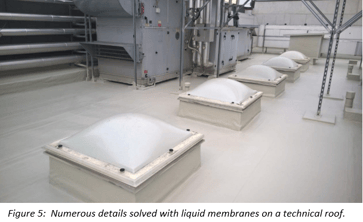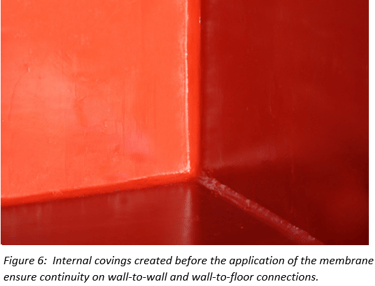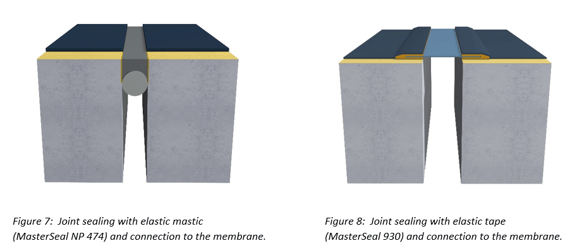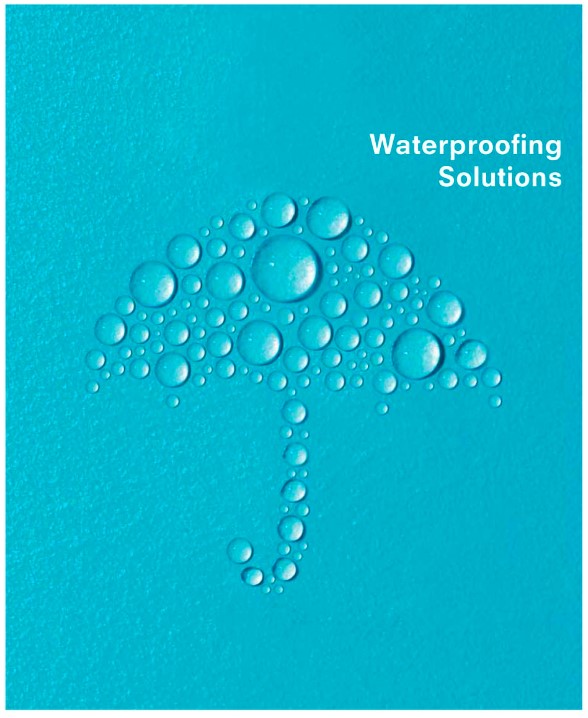The versatility of liquid membranes allows their application for waterproofing of all types of structures, from roofs to cellars, including car parks, and from industrial plants to infrastructures like bridges, dams or water treatment plants.
Liquid membranes form a fully bonded, seamless waterproofing layer that avoids welds and seams which typically represent the weaker spots in any waterproofing system.
But the power of the liquid technology does not show its real benefits before a professional installation is completed. Here are some key tips from waterproofing experts to obtain maximum performance, minimize costs, and ensure customer satisfaction.
1. Do not sacrifice a good substrate preparation.

Liquid membranes require full bonding on the substrates onto which they are applied, and their performance depends on the quality of the adhesion as they have not been designed for a loose laid application.
The advantage of this full adhesion is that these systems prevent the water circulation between the layers even if the membrane is damaged, helping the detection, localization and repair of potential leakages.
But this requires the maximum attention to the preparation of the substrate that will receive the waterproofing system, cleaning and removing all elements (including existing previous treatments) that can complicate the adhesion or, even worse, can generate a “fake” adhesion (i.e. adhesion on a layer which is not cohesive). Also, every product has specific requirements regarding residual humidity on concrete substrates.
Any improper surface preparation may lead to the debonding (i.e. complete failure) of the application, resulting in degradation, downtime of the installations, need of further repairs, and, consequently, added expenses.
2. Always use a primer.

You probably know that a primer has the purpose to increase adhesion, although most liquid membranes would not require a primer to achieve a good adhesion on concrete. But primers have other important functions, too:
- They reduce the risk of air bubbles emerging from the substrate into the membrane
- They provide a uniform surface for further membrane applications
- They remove remaining dust on the concrete substrate
- They play a decisive role in reducing the risk of debonding and blistering in case if
ofresidual moisture is present in the concrete
Resin-based membranes often require products which have been specially formulated for their use as primers. A common characteristic of these primers is a low viscosity to ensure penetration into the porous and rough concrete surface.
When it comes to cementitious membranes, the case looks slightly different: instead of priming with a specific product, the application of a “bonding slurry” is required, which is usually made by simply adding extra water to the same product. This allows reducing the viscosity of the product and thus improving the close contact with the substrate roughness.
3. Favor crack bridging membranes.

The reason is simple: liquid membranes are totally connected to substrate. This means that every movement of the substrate will impact the membrane. A rigid waterproofing system will reflect any crack that opens in the substrate, whereas an elastic, crack bridging membrane will maintain its continuity even when unexpected cracks appear.
An additional benefit is protection: coatings and membranes applied on the concrete surfaces crack bridging capacities ensures protection against the penetration of water or aggressive chemicals, preventing leakages and further concrete degradation.
4. Do not tamper with consumption (i.e. applied thickness).

There are several reasons why the producer’s recommendation about the applied thickness of the membrane should be followed.
First, elastic membranes bridge unexpected cracks by deforming themselves and by suffering elongation that reduces thickness. Therefore, an insufficient thickness will put the continuity of the membrane at risk.
Second, a substrate like concrete is always irregular, so unless an extensive surface preparation is done, an insufficient thickness of the membrane may not cover all the irregularities of the substrate.
And third, a protective membrane represents a barrier against water, aggressive chemicals and gases. All substances have a certain diffusion capacity through the membranes, and therefore isolation capacities are always linked to the applied thickness. For example, a material is considered Radon tight if its applied thickness is more than three times the diffusion penetration length obtained by testing. Read more in our blog post “How to prevent Radon gas penetration in concrete structures”.
5. The devil is in the details.

Joints, cracks, fixings, connections, and many more are points where the major risk of waterproofing failure is concentrated.
Although liquid membranes represent an easier detailing solution, in contrast to prefabricated sheets, this does not mean that these points do not require special attention.
Anchoring bases, mechanical fixings, surface mounted installations, etc., can have different configurations, but all of them can be completely covered by a continuous layer of the liquid waterproofing system.
The case of roof drains is quite simple as it only requires spraying the liquid membrane with additional consumption of at least 40 cm around the drain perimeter.
And finally, corners with sharp edges or internal corners (wall-to-floor or wall-to-wall) must be smoothed and rounded to avoid concentration of tension in case of movements of different elements.

6. Treat all movement joints properly.
Joints are necessary for concrete structures for a variety of reasons. Small concrete movements that lead to cracking can be compensated using elastic or crack bridging membranes. However, movements of structures can vary: depending on daily and seasonal variations in temperature or sunlight or functional or structural variations of different elements of a concrete structure, crack bridging membranes may not be enough and movement joints have to be treated by proper sealing using elastic mastics or tapes.
In this case, it is necessary to ensure a proper connection between the waterproofing membrane and the joint sealing system from one side so that the joint sealing system maintains its movement capacity and the water cannot penetrate the connection between the joint and the waterproofing membrane.

And the last one, the trick of the experienced specialists …
7. Consider the additional benefits of the waterproofing membrane.
The basic job of a waterproofing membrane is to provide a barrier against liquid water to prevent it from passing from one side to the other of the structure. As long as all previous points have been carefully considered, all membranes will do this. There is no membrane that is less than 100% impermeable.
But depending on the application of the membrane, waterproofing membranes can meet additional requirements of this application.
- In biogas tanks, high chemical resistance and impermeability to methane will be required. Read more here: Methane and biogas containment
- In highly contaminated areas where concrete is exposed to the effects of CO2, it will be good to apply a membrane that offers high capacities to protect the structure against carbonation. Read more here: Increase insufficient concrete cover to reinforcement using coatings and membranes
- In the case of roof waterproofing, the membrane should offer high resistance to weathering. This will ensure protection against sunlight, rain and snow. Read more here: Is one single solution for all types of roofs possible?
- If the membrane is used in a trafficked surface like a car park, it will need to prove high durability in exposed conditions and a high mechanical (abrasion, wear and impact) resistance. Read more here: Car parks, what makes the difference
- In drinking water tanks, the proper waterproofing membrane can help ensure constant water quality. Here local legislations should be considered as requirements vary geographically. More information can be found here: The challenges of water containment
Last, but not least, waterproofing membranes also contribute to sustainability by reducing the environmental impact and economic costs of structures. They reduce concrete degradation which may lead either to a costly repair and refurbishment operation or, even worse, to the demolition and re-construction of the structure.
